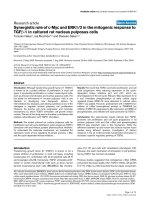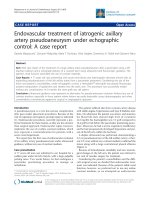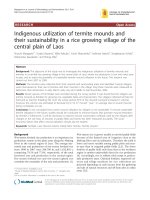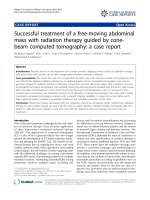Báo cáo y học: " Successful treatment of Candida parapsilosis and Pseudomonas aeruginosa infection using medical and surgical management in an injecting drug user with mitral and aortic valve endocarditis: a case report" doc
Bạn đang xem bản rút gọn của tài liệu. Xem và tải ngay bản đầy đủ của tài liệu tại đây (186.26 KB, 3 trang )
Case report
Open Access
Successful treatment of Candida parapsilosis and Pseudomonas
aeruginosa infection using medical and surgical management in
an injecting drug user with mitral and aortic valve endocarditis:
a case report
Hanady Daas
1
, Fadi Abuhmaid
1
and Marcus Zervos
1,2,3
*
Address:
1
Department of Internal Medicine, Henry Ford Hospital, 2799 W Grand Blvd, Detroit, MI 48202, USA,
2
Department of Infectious Disease,
Henry Ford Hospital, 2799 W Grand Blvd, Detroit, MI 48202, USA and
3
Wayne State University, Detroit, MI, USA
Email: HD - ; FA - ; MZ* -
* Corresponding author
Published: 8 May 2009 Received: 8 January 2008
Accepted: 22 January 2009
Journal of Medical Case Reports 2009, 3:6598 doi: 10.1186/1752-1947-3-6598
This article is available from: />© 2009 Daas et al; licensee Cases Network Ltd.
This is an Open Access article distributed under the terms of the Creative Commons Attribution License (
/>which permits unrestricted use, distribution, and reproduction in any medium, provided the original work is properly cited.
Abstract
Introduction: Polymicrobial endocarditis is a well-recognized problem in intravenous drug users and it
accounts for 1 to 3% of endocarditis cases overall and up to 9% in other series. The most common
combinations of organisms include Staphylococcus aureus and Streptococcus pneumoniae followed by
Staphylococcus aureus and Pseudomonas aeruginosa. Candida parapsilosis endocarditis carries a mortality
rate of 45%, and each infection with Candida or Pseudomonas endocarditis per se carries a very high
mortality rate approaching 85% and 80%, respectively. The combination of P. aeruginosa and C. parapsilosis
has never been encountered and there have been no earlier reports of the combination of C. parapsilosis
and P. aeruginosa in adult intravenous drug users as a cause of endocarditis.
Case presentation: We present a 49-year-old man with bivalvular endocarditis with P. aeruginosa
and C. parapsilosis. He had a prior bivalvular replacement in 2005 that became infected with the above
microorganisms and he was treated with intravenous antibiotics. Because of ongoing intravenous
drug use, a second valve replacement was denied. A few days later, the patient presented with septic
shock secondary to P. aeruginosa and C. parapsilosis recurrent endocarditis. The infection was cured
with a second bivalvular replacement and extended therapy with antibiotics and antifungals.
Conclusion: This is the first time a patient has presented with P. aeruginosa and C. parapsilosis
endocarditis. Relapsing polymicrobial endocarditis can be cured with medical and surgical therapy.
Introduction
Few data exist on infective endocarditis in intravenous
drug use (IVDU) patients. A new pattern of infective
endocarditis in IVDU is emerging, characterized by more
frequent left heart involvement, a severe clinical course,
and a need for surgery in the active phase [1]. The standard
of care has included periop erative antifungal, radical
debridement of infected tissue, reconstruction using
Page 1 of 3
(page number not for citation purposes)
biological tissue when possible, and prolonged oral
suppressive antifungal therapy. Medical treatment of
fungal endocarditis on prosthetic valves can be successful
in selected cases. Left-sided endocarditis compared to
right, and polymicrobial compared to single organism, are
well known risk factors for an increase in morbidity and
mortality in intravenous drug users with infective endo-
carditis [2].
Case presentation
A 49-year-old man with a history of intravenous drug
abuse, mainly heroin, presented to the emergency depart-
ment in Henry Ford Hospital where he complained of
chills and diarrhea. The diarrhea was watery and contin-
uous of 1-day duration accompanied by chills. He denied
shortness of breath or chest pain.
Our patient was hospitalized in another facility 14 days
before presenting to the emergency department of our
hospital, and was found to have Candida parapsilosis and
Pseudomonas aeruginosa endocarditis. A 2D echocardio-
gram was done there and showed vegetation of the
prosthetic mitral valve, with normal aortic prosthesis. He
was discharged with a peripherally inserted catheter (PIC)
line and on intravenous antibiotics namely, tobramycin,
cefepime and fluconazole. No valve replacement was
performed at that time due to ongoing injection drug use.
He was only out for 1 day before presenting to our
emergency department.
His past medical history was significant for aortic and
mitral valve replacement 1 year before this hospitalization
for endocarditis. He also had stage 3 chronic kidney
disease.
At initial presentation, he was found to be febrile at 100.3°F
and hypotensive at a blood pressure of 85/50. His physical
examination revealed a 3/6 systolic murmur in the aortic
area with radiation to the precordium, and a 2/6 diastolic
murmur over the mitral area without radiation.
His initial laboratory investigations showed white blood
cell count of 19.2k/μL with 93% neutrophils, hemoglobin
of 9.6g/dL, blood urea nitrogen (BUN) 26mg/dL,
creatinine 2.2mg/dL, serum bicarbonate 16mmol/L,
chloride 112mmol/L, sodium 136mmol/L, magnesium
1.2mmol/L. Prothrombin time was 15 seconds, and
international normalized ratio (INR) was 1.17. Urine
toxicology screen was positive for benzodiazepines.
Troponin level was 2.2ng/mL (normal<0.4). Initial
blood cultures were drawn in the emergency department
and later grew P. aeruginosa susceptible to amikacin,
aztreonam, cefepime, ciprofloxacin, imipenem, piperacil-
lin/tazobactam and tobramycin. Serology was positive for
Hepatitis C infection and negative for HIV infection.
On presentation, he was admitted to the intensive care
unit with the diagnosis of septic shock. He was started on
intravenous vancomycin, tobramycin, micafungin and
cefepime.
Three sets of blood cultures grew C. parapsilosis susceptible
to fluconazole, itraconazole and 5 flucytosine, and
P. aeruginosa susceptible to amikacin, aztreonam, cefe-
pime, ciprofloxacin, imipenem, piperacillin/tazobactam
and tobramycin.
A 2D echocardiogram showed a bioprosthetic aortic valve
with a medium, 10mm, pedunculated, highly mobile
vegetation of the aortic valve attached to the posterior
aortic annulus. There was no significant aortic valvular
regurgitation. There was mild mitral valvular regurgitation.
At day 2 of hospitalization, a transesophageal echocardio-
gram was done. It showed no aortic abscess but small,
5mm, mobile vegetation of the aortic valve attached to the
non-coronary cusp without significant regurgitation. It
also showed large, 10mm, mobile mitral valve vegetation
attached to the anterior leaflet without significant
regurgitation.
The hospital course was complicated by acute renal failure
and acute heart failure for which the patient was
aggressively resuscitated. He was electively intubated and
medically stabilized to undergo valve replacement 5 days
later. Ethical and logistic considerations were the focus of
an extensi ve discussion among the different treating
medical and surgical teams given the active injecting
drug use while being treated for a relapse of infective
endocarditis. The decision was finally made to proceed
with the valve replacement surgery. The patient was kept in
hospital for the duration of intravenous antibiotics to
ensure adherence to therapy and to prevent use of the
intravenous access for illicit drug use.
At day 7 of hospitalization, he underwent aortic and mitral
valve replacement. Cultures from the valves also grew
P. aeruginosa and C. parapsilosis. All blood cultures drawn
after day 1 were negative.
Tobramycin and cefepime were given for 6 weeks post-
operatively. Tobramycin trough levels were measure d
frequently to ensure therapeutic levels. Micafungin was
given for 5 days postoperatively, and replaced by
anidulafungin that was given for 26 days. Fluconazole
was given for 30 days postoperatively while in hospital
and prescribed for 3 months after discharge from the
hospital.
Throughout hospitalization, he remained afebrile and
euvolemic without symptoms of heart failure. Two weeks
Page 2 of 3
(page number not for citation purposes)
Journal of Medical Case Reports 2009, 3:6598 />after discharge from the hospital, he returned to the
infectious disease clinic, being in good health, without
history of fever, excess sweating, chest pain or shortness of
breath. Follow-up blood cultures were drawn and were
negative.
Discussion
Polymicrobial endocarditis is a growing problem and has
been attracting increasing attention over the past decade
[3, 4]. The etiology in IVDU is changing, comprising
Staphylococcus, Pseudomonas and other pathogenic fungi
[5, 6]. Most commonly isolated fungi are C. albicans
(24%). Non albicans candida accounts for another 24% of
the fungal isolates [6, 7]. The difficulty arises in the
management of these cases, especially with the growing
resistance to the usual combination antibiotics [8].
This is the first time a patient has pr esented with
P. aeruginosa and C. parapsilosis endocarditis. Optimal
treatment options and cure rate remain to be evaluated.
We present a man who had successful treatment with a
combination of antibiotics and antifungals in addition to
surgical treatment.
Conclusion
Polymicrobial endocarditis with C. parapsilosis and
P. aeruginosa in intravenous drug users can be cured with
surgical valve replacement and extended duration intra-
venous antibiotics and antifungals.
Abbreviations
BUN, blood urea nitrogen; IDU, injecting drug user; INR,
international normalized ratio; IVDU, intravenous drug
use; PIC, peripherally inserted catheter.
Consent
Written informed consent was obtained from the patient
for publication of this case report and any accompanying
images. A copy of the written consent is available for
review by the Editor-in-Chief of this journal.
Competing interests
The authors declare that they have no competing interests.
Authors’ contributions
HD initiated the case report, obtained the consent, and
gathered the patient’s data. FA reviewed the article,
provided some data and contributed to the discussion.
MZ supervised and edited the case report and provided
some of the references.
References
1. Mathew J, Addai T, Anand A, Morrobel A, Maheshwari P, Freels S:
Clinical features, site of involvement, bacteriologic findings,
and outcome of infective endocarditis in intravenous drug
users. Arch Intern Med 1995, 155(15):1641-1648.
2. Carozza A, De Santo LS, Romano G, Della Corte A, Ursomando F,
Scardone M, Caianiello G, Cotrufo M: Infective endocarditis in
intravenous drug abusers: patterns of presentation and
long-term outcomes of surgical treatment. J Heart Valve Dis
2006, 15(1):125-131.
3. Hoen B, Alla F, Selton-Suty C, Béguinot I, Bouvet A, Briançon S,
Casalta JP, Danchin N, Delahaye F, Etienne J, Le Moing V, Leport C,
Mainardi JL, Ruimy R, Vandenesch F: Association pour l'Etude et la
Prévention de l'Endocardite Infectieuse (AEPEI) Study
Group: Changing profile of infective endocarditis: results of
a 1-year survey in France. JAMA 2002, 288:75-81.
4. Brito LR, Guimarães T, Nucci M, Rosas RC, Paula Almeida L,
Da Matta DA, Colombo AL: Clinical and microbiological aspects
of candidemia due to Candida parapsilosis in Brazilian tertiary
care hospitals. Med Mycol 2006, 44(3):261-266.
5. Shively BK: Infective endocarditis.InCurrent Diagnosis & Treatment
in Cardiology. 2nd edition. Edited by Crawford MH. McGraw Hill; 2003.
6. Ellis ME, Al Abdly A, Greer W, Ventura W: Fungal endocarditis:
evidence in the world literature 1965-1995. Clin Infect Dis 2001,
32(1):50-62.
7. Butkevich OM, Vinogradova TL: [Some problems of the current
therapy of infective endocarditis.] Ter Arkh 2000, 72(9):54-57.
8. Moreillon P, Que Y: Infective endocarditis. Lancet 2004,
363:139-149.
Page 3 of 3
(page number not for citation purposes)
Journal of Medical Case Reports 2009, 3:6598 />Do you have a case to share?
Submit your case report today
• Rapid peer review
• Fast publication
• PubMed indexing
• Inclusion in Cases Database
Any patient, any case, can teach us
something
www.casesnetwork.com









